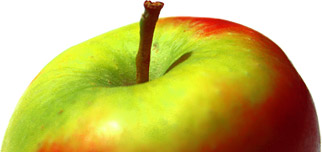Vista Bella is a very early season dessert apple. It ripens in mid-July in southern England, making it probably the earliest apple of the season.
Vista Bella was developed at Rutgers University in New Jersey, USA, in the 1950s. It is grown commercially on a small-scale, particularly in the USA. The name "Vista Bella" comes from the Guatamalan highlands where it is also grown.
Vista Bella is a medium-sized apple, with a light yellow-green skin, flushed deep red where exposed to the sun. The color frequently changes to a solid crimson when ripe or over-ripe in good sunlight. For such an early variety the flavour is remarkably good, with a distinctly fruity taste reminiscent of slightly under-ripe raspberries. The flesh is light and juicy, and this apple is very easy and enjoyable to eat. If you have been surviving on old supermarket apples stored from the previous season, then Vista Bella is a revelation, with its full-on taste of the summer.
However, there are some caveats. Like all early apples Vista Bella does not keep. If you are buying from a farm shop make sure you find out what day the apples have been picked, since anything more than a few days old will not be worth having. The excellent flavour and crispness decays very rapidly after picking - to the point where that 9-month old supermarket Golden Delicious will be far nicer! Store them in the fridge, not the fruit bowl, and serve them whilst still cool.
Given these limitations, growing your own Vista Bella is probably the best way to ensure you can get some of these lovely apples. Trees are available from specialist nurseries, and you should be successful although this apple variety is susceptible to canker - but as Hessayon so aptly states in his book "The Fruit Expert", being able to pick bright red apples in July is worth a few problems.
USDA identification images for Vista Bella
The identification paintings in the USDA Pomological Watercolor Collection span the years 1886 to 1942.
Citation: U.S. Department of Agriculture Pomological Watercolor Collection. Rare and Special Collections, National Agricultural Library, Beltsville, MD 20705.
Visitor reviews
Tree register
United States
- Jo Elsmore in BLOORS,
- Joel Howie in Canton, NEW YORK
- Lance Barker in Canyon City, OR
- Rick Simoniello in Storrs / Mansfield, CT
United Kingdom
- Elizabeth Moriarty in Oxford, OXON
- Richard Borrie in York, YORKSHIRE
- Vincent Bentley in Montgomery, POWYS
Spain
- Jorge Ramirez in VALENCIA, VALENCIA
Canada
- Fred Rode in Pictou, NOVA SCOTIA
- Nancy Wilson in Peterborough, ONTARIO ,
Australia
- a Bear in TOOLANGI, VIC
- Hayden in Winslow, VICTORIA, AUSTRALIA
- Jenny in Melbourne, VICTORIA,
- Lydia Kokotos in Lower Wattle Grove, TASMANIA, AUSTRALIA
Russia
- Ann in Manturovo, KOSTROMA OBLAST
Spring blossom records for this variety
2015 season
- 24th May 2015 - tree owned by Lance in Canyon City, United States
2014 season
- 1st June 2014 - tree owned by Lance in Canyon City, United States
2013 season
- 14th May 2013 - tree owned by Richard in York, United Kingdom
2011 season
- 26th June 2011 - tree owned by Lance in Canyon City, United States
Record your blossom dates in our Fruit Tree Register - more >>.
Harvest records for this variety
2011 season
- 3rd week September 2011 - tree owned by Lance in Canyon City, United States
Origins
- Species: Malus domestica - Apple
- Parentage: Julyred, Starr and others
- Originates from: New Brunswick, New Jersey, USA, United States
- Introduced: 1956
- Developed by: New Jersey Agricultural Experiment Station
- UK National Fruit Collection accession: 1971-048
- Some historical details taken with kind permission from 'The New Book of Apples' by Joan Morgan and Alison Richards , illustrated by Elisabeth Dowle, published by Ebury Press, 2002.
Identification
- Country of origin: United States
- Period of origin: 1950 - 1999
- Fruit colour: Red / Green
Using
- Picking season: Early
- Keeping (of fruit): 1-3 days
- Flavour quality: Good
- Cropping: Heavy
- Food uses: Eating fresh
Growing
- Gardening skill: Average
- Flowering group: 2
- Ploidy: Diploid
- Precocity: Precocious
- Self-fertility: Not self-fertile
Other qualities
- Disease resistance: Average
Where to buy fresh fruit
The following orchards grow Vista Bella:
United States
Iowa
- Wilson's Orchard, Iowa City
Maine
- Pietree Orchard, Sweden
- Sweetser's Apple Barrel and Orchards, Cumberland Center
Massachusetts
- Nicewicz Farm, Bolton
- Red Apple Farm, Phillipston
- Russell Orchards, Ipswich
New York
- Rulfs Orchard, Peru
Pennsylvania
- Masonic Village Farm Market, Elizabethtown
- Shaw Orchards, Stewartstown
Canada
British Columbia
- Salt Spring Apple Company, Salt Spring Island
Ontario
- Organics Farm, Markham
References
- Fruit Expert
Author: Hessayon

